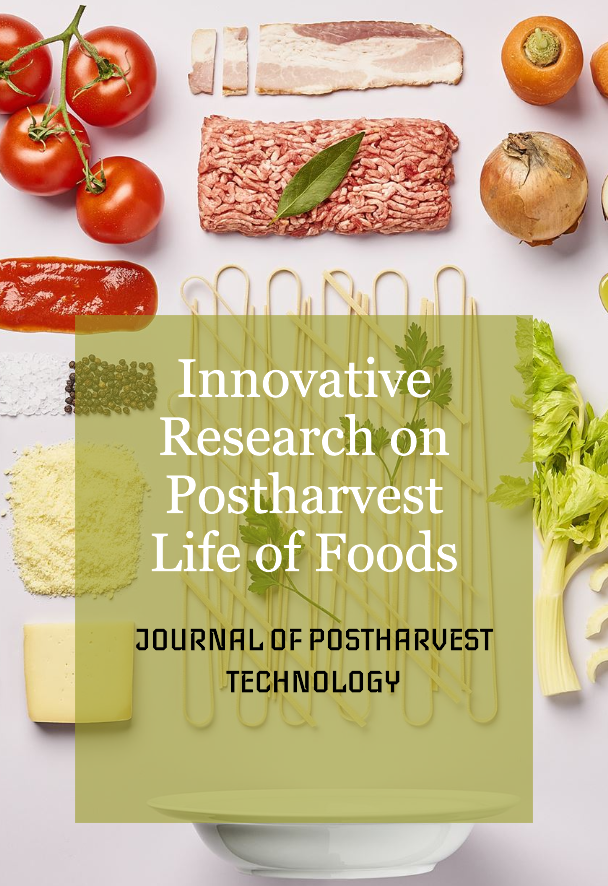Studies on the drying of oyster mushrooms (Pleurotus sajor-caju) and its utilization in mushroom-incorporated cookies
DOI:
https://doi.org/10.48165/jpht.2024.12.2.08Keywords:
Cookies, hot air oven drying, organoleptic evaluation, oyster mushroom, vacuum oven dryingAbstract
The present investigation was carried out to study the drying of oyster mushrooms by involving two methods, namely hot-air oven drying and vacuum drying, after different pre-treatments. There was a decrease in browning of mushrooms dried after blanching and steeping in anti-browning agents such as citric acid (0.5%) and ascorbic acid (0.5%). The browning was observed to be lowest in vacuum-dried mushrooms compared to hot-air oven-dried mushrooms. Therefore, the mushrooms dried by vacuum drying techniques, pre-treated with citric acid (0.5%) and ascorbic acid (0.5%) solutions after blanching, were utilized for the preparation of mushroom powder for incorporation in cookies. The cookies were prepared by incorporating mushroom powder at 5%, 10%, and 15% by replacing wheat flour and were subjected to organoleptic evaluation by a semi-trained panel. The cookies were moderately acceptable, having an organoleptic score of more than 7.0 as per a 9-point hedonic rating scale. However, the cookies containing a higher level of mushroom powder (15%) scored slightly lower (having an overall score of less than 7) compared to other formulations. These products can provide significant support against protein-energy malnutrition (PEM), obesity, cardiovascular diseases, diabetes, and other lifestyle disorders that have a wide prevalence in different sections of society.
References
A.O.A.C. (1990). Official Methods of Analysis (15th ed.). Association of Official Analytical Chemists, Washington, D.C.
Alam, N., Amin, R., Khan, A., Ara, I., Shim, M.J., Lee, M.W., Lee, U.Y., & Lee, T.S. (2009). Comparative effects of oyster mushrooms on lipid profile, liver and kidney function in hypercholesterolemic rats. Mycobiology, 37(1), 37-42.
Bahl, N. (2002). Handbook on Mushrooms. Oxford and IBH Publishing Company Pvt. Ltd., New Delhi.
Bisaria, R., Vasudevan, P., & Bisaria, V. (1990). Utilization of spent agro-residues from mushroom cultivation for biogas production. Applied Microbiology and Biotechnology, 33, 607-609.
Chandra, S., & Samsher, S. (2002). Studies on quality of dehydrated oyster mushroom as influenced by various pre-treatments and drying method. Mushroom Research, 11, 107-112.
Deepalakshmi, K., & Sankaran, M. (2014). Pleurotus ostreatus: An oyster mushroom with nutritional and medicinal properties. Journal of Biochemical Technology, 5(2), 718-726.
Deshpande, A., & Tamhane, D. (1981). Studies on dehydration of mushrooms (Volvariella volvacea). Journal of Food Science and Technology, 18(3), 96-101.
Dunkwal, V., Jood, S., & Singh, S. (2007). Physico-chemical properties and sensory evaluation of Pleurotus sajor caju powder as influenced by pre-treatments and drying methods. British Food Journal, 109(9), 749-759.
Kakon, A., Choudhury, M. B. K., & Saha, S. (2012). Mushroom is an ideal food supplement. Journal of Dhaka National Medical College and Hospital, 18(1), 58-62.
Kumar, K. (2020). Nutraceutical potential and processing aspects of oyster mushrooms (Pleurotus species). Current Nutrition and Food Science, 16(1), 3-14.
Kumar, K., & Barmanray, A. (2007). Nutritional evaluation and storage studies of button mushroom powder fortified biscuits. Mushroom Research, 16(1), 31-35.
Manzi, P., Aguzzi, A., & Pizzoferrato, L. (2001). Nutritional value of mushrooms widely consumed in Italy. Food Chemistry, 73(3), 321-325.
Miles, P. G., & Chang, S. T. (1997). Mushroom biology: Concise basics and current developments. World Scientific.
Nadew, T. T., Reshad, A. S., & Tedla, T. S. (2024). Oyster mushroom drying in tray dryer: Parameter optimization using response surface methodology, drying kinetics, and characterization. Heliyon, 10(2), e24623.
Rai, R., & Arumuganathan, T. (2008). Economics for pickling. Post Harvest Technology. Technical Bulletin, NRCM, Solan, 68-69. Ranganna, S. (1986). Handbook of analysis and quality control for fruit and vegetable products. Tata McGraw-Hill Education.
Tiram, C. (2013). Effect of different drying techniques on the nutritional values of oyster mushroom (Pleurotus sajor-caju). Sains Malaysiana, 42(7), 937-941.
WHO, F. (1973). Energy and protein requirements. Paper presented at the Geneva: FAO/WHO. (FAO Nutrition Meetings Report Series 52).
Vaintraub, I.A., & Lapteva, N.A. (1988). Colorimetric determination of phytate in unpurified extracts of seeds and the products of their processing. Analytical Biochemistry, 175(1), 227-230.
Ainsworth, E.A., & Gillespie, K. M. (2007). Estimation of total phenolic content and other oxidation substrates in plant tissues using Folin–Ciocalteu reagent. Nature Protocols, 2(4), 875.








